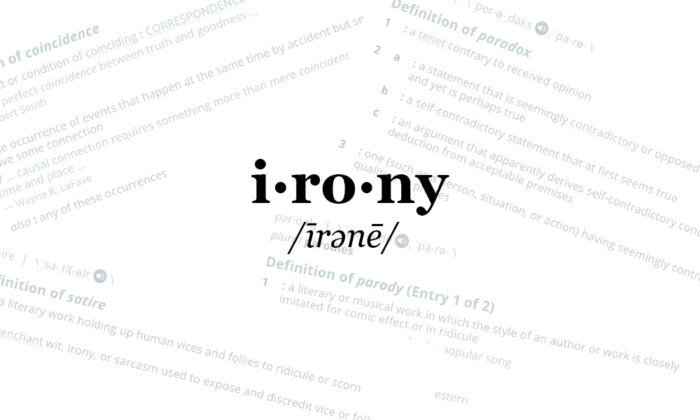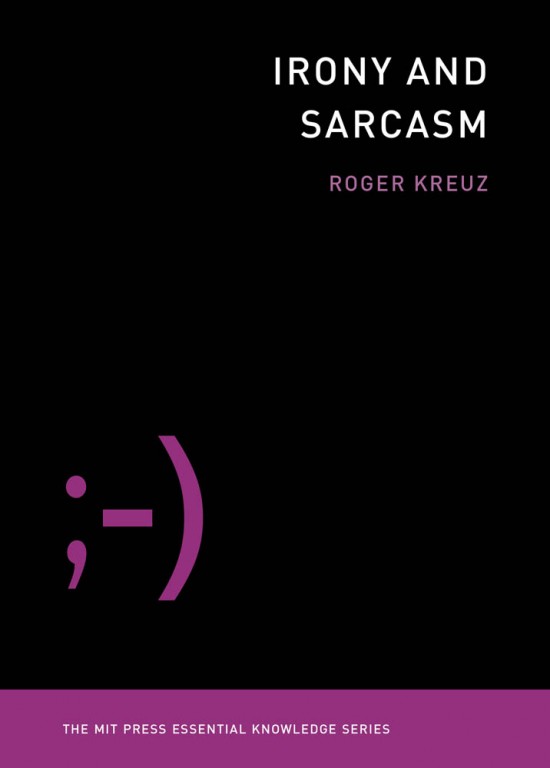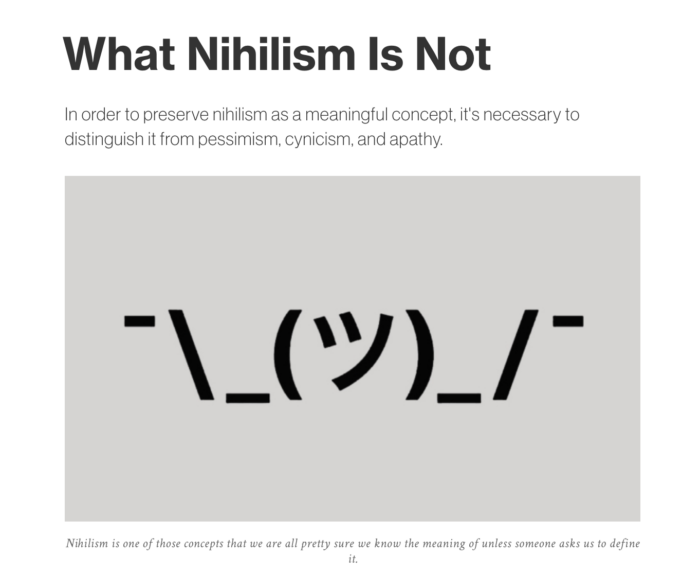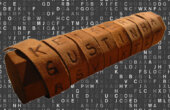What Irony Is Not

“Irony” is a term that everyone uses and seems to understand. It is also a concept that is notoriously difficult to define. Much like Winona Ryder’s character in the 1994 rom-com “Reality Bites,” whose inability to describe irony costs her a job interview, we know it when we see it, but nonetheless have trouble articulating it. Even worse, it seems as if the same term is used to describe very different things. And following your mother’s advice — to look it up in the dictionary — is liable to leave you even more confused than before.

Uncertainty about irony can be found almost everywhere. An American president posts a tweet containing the phrase “Isn’t it ironic?” and is derided for misusing the term. A North Korean dictator bans sarcasm directed at him and his regime because he fears that people are only agreeing with him ironically. A song about irony is mocked because its lyrics contain non-ironic examples. The term has been applied to a number of different phenomena over time, and as a label, it has been stretched to accommodate a number of new senses. But exactly how does irony differ from related concepts like coincidence, paradox, satire, and parody?
Coincidence
In everyday conversation, the term “coincidence” is often used as a synonym for situational irony. For example, someone might rhetorically exclaim, “Isn’t it ironic that the rain stopped just as I was finishing my morning run?” In many such instances, “coincidence” would probably be a better descriptor, particularly when no greater meaning or import connects the two events. Things happen all the time, and sometimes things happen at the same time. But does that make such juxtapositions ironic? And does it truly matter what we call them?
Referring to coincidences as ironic raises the hackles of prescriptivists, who regard such usage with clear distaste. For them, it represents a form of imprecision that debases the language — an unforced error that one should scrupulously avoid. From a family resemblance perspective, we might say that the concept of coincidence overlaps to some degree with the irony concept, but the number of attributes the two share is low. Coincidences involve juxtaposition and incongruity, but they aren’t counterfactual and don’t involve pretense. They may allude to failed expectations, but they aren’t explicit echoes. Coincidences may involve victims, humor, or criticism, but they are rarely truly humorous or poignant. In short, the family resemblance between coincidence and irony makes them more like cousins than siblings.
The battle over equating irony and coincidence has been raging for some time. The first edition of “Fowler’s Modern English Usage” (1926) claims that “a protest is needed against the application … of ‘irony’ … to every trivial oddity.” Seventy years later, the third edition admitted that “this weakened use looks as if it has come to stay,” and the fourth edition, published in 2015, refers darkly to “vague, watered down newer meanings” of irony.
The 2015 edition of The New York Times Manual of Style and Usage states that “the looser use of irony and ironically, to mean an incongruous turn of events, is trite. Not every coincidence, curiosity, oddity and paradox is an irony, even loosely.” It is interesting to note that in the 1999 edition there followed another sentence that has been omitted from the current edition: “And where irony does exist, sophisticated writing counts on the reader to recognize it.” Perhaps the editors of the guide realized they were fighting a losing battle on that point?
Equating irony with coincidence is still viewed — at least in some quarters — as a semantic transgression, although attitudes appear to be softening.
Other disapproving voices have weighed in on this issue. The American Heritage Dictionary provides a usage note for “ironic” that addresses this distinction: “Sometimes, people misapply ironic, irony, and ironically to events and circumstances that might better be described as simply coincidental or improbable, with no particular lessons about human vanity or presumption. Resistance to such uses remain strong.” The usage note is buttressed with data from the dictionary’s usage panel, a group of nearly two hundred journalists, creative writers, and scholars who complete annual surveys on the “acceptability” of word senses and grammatical constructions. The panel has been asked repeatedly to weigh in on the acceptability of a sentence that describes a woman from Ithaca, New York, who moves to California, where she meets and marries a man who is also from upstate New York. The sentence uses the word “ironically” to describe this outcome. In 1978, 78 percent of the panel rejected this usage. A survey from 2016 that contained the same sentence was deemed problematic by 63 percent of the panel, a figure that is lower than the earlier one but still a majority. Clearly, equating irony with coincidence is still viewed — at least in some quarters — as a semantic transgression, although attitudes appear to be softening. However, the shift may also have to do with the changing composition of the American Heritage’s usage panel over time.
To explore this debate more fully, let’s consider a larger question: what exactly is a coincidence, anyway? As might be expected, different dictionaries take different approaches, but Merriam-Webster defines it as “the occurrence of events that happen at the same time by accident but seem to have some connection.” Needless to say, this formulation leaves plenty of room for interpretation, since a perception of “some connection” is inherently subjective.
A good example of this subjectivity can be found in “Brain Droppings,” by the comedian George Carlin. He argues that the concept of irony has to do with opposites and has “nothing to do with coincidence.” He provides a number of examples to make his point, including the following: “A diabetic, on his way to buy insulin, is killed by a runaway truck. He is the victim of an accident. If the truck was delivering sugar, he is the victim of an oddly poetic coincidence. But if the truck was delivering insulin, ah! Then he is the victim of an irony.” At first blush, Carlin’s argument appears persuasive: A diabetic being hit by a truck delivering insulin does seem more ironic than a truck delivering sugar. It’s likely, however, that many people would characterize the “diabetic–sugar truck” juxtaposition as ironic as well: There clearly exists “some connection” between diabetes and sugar that seems to elevate such a pairing past mere coincidence.
Other examples, however, appear to be more straightforward. In “The Gift of the Magi” (1905), O. Henry tells the story of Jim and Della, a young couple seeking the perfect Christmas presents for each other (spoiler alert!). Both of them sacrifice prized possessions to be able to afford their gifts. Della has her lustrous tresses shorn so that she can afford a platinum pocket watch fob for Jim. Jim sells his pocket watch to buy ornamental combs for Della. Their actions thus destroy the value of the gifts that they exchange. The story is best described in terms of situational irony, with a dash of dramatic irony as well, since the reader is aware of the poignant outcome before Jim and Della meet to celebrate Christmas. It would be strange to describe the story’s outcome as merely a coincidence; this would seem to undercut the peculiarly symmetrical results of Jim and Della’s sacrifices. But does “The Gift of the Magi” rise to the level of providing “lessons about human vanity or presumption,” as dictated by the American Heritage definition? Perhaps, although it’s difficult to imagine widespread agreement on the necessary and sufficient criteria for vanity and presumption.
It is worth asking oneself, before describing such occurrences, whether a juxtaposition is mundane (that is, coincidental) or more surprising, consequential, or significant — and therefore ironic.
Both situational irony and coincidence are used to refer to states of affairs that may be difficult to classify as clearly belonging to one concept or the other. And attempts to cleanly differentiate between them may be a fool’s errand. The most we can say is that some people care about the distinction a great deal, and it is worth asking oneself, before describing such occurrences, whether a juxtaposition is mundane (that is, coincidental) or more surprising, consequential, or significant — and therefore ironic.
Paradox
As with coincidence, irony is often conflated with the concept of paradox. Once again, the two concepts overlap to a certain degree, since both irony and paradox can involve juxtaposition, sometimes jarring incongruity, and deviation from expectations. Paradox, however, goes a step further and entails self-contradiction as an essential element.
Paradox, like irony, has a long tradition in Western thought, but principally in the realm of logic as opposed to rhetoric. In her book on paradox, the philosopher Margaret Cuonzo notes three principal uses of the term. The definition most relevant for our purposes is “an argument with seemingly true premises, seemingly good reasoning, and an obviously false or contradictory conclusion.”
Paradox, like irony, has a long tradition in Western thought, but principally in the realm of logic as opposed to rhetoric.
The crucial issue that separates verbal irony from paradox is that the apparent contradiction can, in fact, be resolved. If someone mutters, “What lovely weather we’re having!” as they crouch in a tornado shelter, the statement would appear to stand in stark contrast to the true state of affairs. However, conversational participants implicitly assume that a cooperative principle is always in effect. This seemingly absurd remark, therefore, must make sense in some way. The contradiction leads the listener to make a context-specific inference — an implicature — that can resolve the apparent inconsistency. Someone who hears such a remark can draw on cultural expectations regarding the weather and conclude that the speaker intends some related proposition, such as its exact opposite. So what appears to be a contradiction can be bridged with a little world knowledge.
As with coincidence, the shared family resemblance between paradox and irony is low. Once again, we see the common element of incongruity, but little else. That is not to say that philosophers and literary critics haven’t muddied the waters with regard to paradox and irony. Friedrich Schlegel, the German poet, philosopher, and literary critic, declared that “irony is the form of paradox. Paradox is what is good and great at the same time.” The meaning of this fragmentary idea, however, is obscure. Cleanth Brooks, the scholar who helped establish the New Criticism movement, wrote in “The Well Wrought Urn” that “the language of poetry is the language of paradox.” Brooks meant that the underlying meaning of a poem can be contradictory to its surface form, although he did not use the term “irony” to refer to this contradiction. Finally, Norman Knox proposed a category of paradoxical irony in which “everything is relative. … Author and audience fuse, or oscillate between identification and detachment.” However, this seems to be more of a restatement of romantic irony than a new use of the term.

To the degree that nonscholars use the term “paradoxical irony,” it seems to function as a mere intensifier for the concept of irony or coincidence. The phrase is not common: It appears only twice in a 14-billion-word sample of 22 million web pages provided in a searchable corpus known as iWeb. The first appears in a review of Sheryl Crow’s album “Be Myself”:
It seems the title is a reminder, but there’s paradoxical irony in having to remind yourself to be yourself.
The second case also occurs in the context of a review, in this case the book “Jacques Derrida’s Aporetic Ethics”:
The paradoxical irony began with Socrates being the wisest man in Athens because he alone knew he could know nothing.
One could argue that, in both instances, the word “paradoxical” is doing little of the heavy lifting. And neither example suggests the element of self-contradiction that paradoxes typically involve. As in many instances of situational irony, the phrase “paradoxical irony” could be replaced with “it seems strange that” or “it’s odd that” with no loss of meaning.
Satire
Satire works best when it hews close to the line between the outlandish and the possible — and as that line continues to grow thinner, the satirist’s task becomes ever more difficult.
—Graydon Carter, Vanity Fair (2008)
Satire may feel like a relatively new and subversive form of humor, but in reality it has existed for millennia. It appears as early as the fifth century BCE in the Old Comedy of ancient Greece and the plays of Aristophanes. It was fully developed as a genre by Roman authors such as Lucilius, Horace, Persius, and Juvenal. The goal of satire — social criticism by shaming the powerful, the foolish, or the corrupt — can make even ancient examples of the form seem startlingly contemporary.
To appreciate a particular work as satiric, an audience must keep in mind two distinct mental representations simultaneously: the literal meaning of a message and an awareness of a discrepancy between that message and the intention of its author. Richard Roberts and I have argued that this duality gives satire its distinctive character and accounts for satire’s effectiveness as a vehicle for social commentary. The audience has to construct the author’s intentions for themselves by recognizing and accounting for this apparent discrepancy. In this way, satire may represent the ultimate form of the admonition “show, don’t tell.”
The goal of satire — social criticism by shaming the powerful, the foolish, or the corrupt — can make even ancient examples of the form seem startlingly contemporary.
The satirist has many weapons at her disposal, including parody, a form that I discuss separately. She may also employ outlandish exaggeration, blatant falsehoods, and sly innuendo. And virtually all satirists use verbal irony and sarcasm extensively, since these devices are especially well suited to the twin goals of being humorous and critical at the same time.
An important component of irony is pretense, and it is essential for satire as well. The audience of the satirist needs to recognize the pretense of its creator, or else the satire fails as such. When Jonathan Swift made his “modest proposal” that the poor sell their children as food for the rich, it was so extreme that hardly anyone could have perceived it as a serious suggestion. But satire can be much subtler, and in such cases the pretense becomes less clear. For some, it may become invisible.
A prime example can be seen in “The Colbert Report,” in which Stephen Colbert played the role of a bloviating conservative pundit, rarely breaking character. Progressive audiences enjoyed his outlandish claims and proposals as a sophisticated rebuke of perceived excesses by pundits of the far right. However, some conservatives also enjoyed the program and believed that Colbert genuinely meant what he was saying. For those viewers, there was no recognition of Colbert’s pretense. A study conducted by Heather LaMarre and her collaborators showed that a viewer’s political ideology predicted whether or not he or she perceived the program as satiric. Both liberals and conservatives thought that Colbert was funny, but only politically liberal members of his audience were in on the joke.
Both liberals and conservatives thought that Colbert was funny, but only politically liberal members of his audience were in on the joke.
Another essential ingredient of both verbal irony and satire is the existence of common ground. Common ground involves a presupposition of knowledge that two parties share. To understand a work as satiric, audience members use this shared knowledge to recognize that something is not quite right. Common ground can be ephemeral, and if enough time has elapsed, a work of satire may no longer even be recognized as such.
A potential example of this phenomenon is the “Historia Augusta,” which has been the subject of scholarly debate for many years. This Latin manuscript, which purports to be the work of six authors writing in the third century, consists of 30 biographies of Roman emperors, their corulers, and usurpers who reigned from 117 to 285 CE. It also contains nearly 150 extracts from letters, speeches, and Senate proceedings such as decrees and proclamations. It would seem to be a document of considerable historical value, and scholars like Edward Gibbon drew on it when writing their own histories. Over time, however, researchers have found that the manuscript contains a host of inaccuracies and outright falsehoods. As a historical chronicle, there is something seriously wrong with it. This has led to considerable debate about who composed it, when it was written, and, most important, why it was compiled in the first place.
Scholars today believe that the “Historia Augusta” is the work of a single author. It was probably written several decades after its purported date of composition, given the numerous anachronisms that do not fit with the time period being described. Most, if not all, of the letters, speeches, and Senate extracts are thought to have been fabricated. And as a history of the period, it is peculiar, to say the least. Scholars Justin Stover and Mike Kestemont note that the manuscript contains “bizarre details and puzzling omissions, as well as [a] lurid focus on emperors’ peccadilloes and personal habits to the detriment of their political accomplishments.” In short, the “Historia Augusta” does not appear to be the factual account it claims to be.
Opinions about the purpose of the author have run the gamut from political propaganda to a pagan attack on Christianity. Some classicists, such as Ronald Syme, have emphasized its puns and wordplay, suggesting that the work was simply the musings of a “rogue grammarian.” Shawn Daniels, however, has made a convincing case for the “Historia Augusta” as a work of satire. The “Historia Augusta” may have been intended for a contemporary circle of readers who would have immediately recognized the exaggerations, gaps, and outright fabrications as clever social commentary. Because this audience shared common ground with the author, they were able to appreciate an intent now obscured by the passage of time. It is not hard to imagine archaeologists of the future stumbling across a cache of issues of the The Onion and scratching their heads over headlines like “Obama under Fire for Playing T-Ball during Vietnam.”
Finally, sharing common ground is essential for appreciating the purpose of satire. A satiric critique may be perceived as humorous by members of one community but as offensive or even blasphemous by members of another. The 2015 Al-Qaeda attack on the offices of the French satirical magazine Charlie Hebdo is a tragic example of what can happen when satire is perceived as sacrilege.
Recognizing pretense and sharing common ground are essential for understanding both verbal irony and satire. As a result, the two terms are sometimes used synonymously. But not all irony is satiric, and not all satire employs irony. To complicate matters further, satire is often confused with parody, our next topic.
Parody
Satire is a lesson, parody is a game.
—Vladimir Nabokov
As we have seen, pretense is an essential component of many forms of irony, and this holds true for parody as well. At its heart, a parody is an intentional imitation of something else, although the goals of the parodist vary. At one extreme, the intent may be to gently poke fun at the original work or its creator. At the other extreme, however, it may involve full-throated condemnation. The more aggressive forms of parody liberally use exaggeration, satire, and sarcasm to ridicule the authentic work and, by extension, the person who produced it. The overlap of these figurative forms and genres can lead to confusion and cause them to be mistaken for one another.
As a literary genre, parody, like satire, dates back to the Old Comedy of ancient Greece. Its first practitioner may have been Hegemon of Thasos, who lived during the fifth century BCE. The form has been popular in Western literature for several centuries. Examples run the gamut from parodies of chivalric romance (Chaucer’s Sir Thopas in “The Canterbury Tales”) and heroic narratives (Pope’s “Rape of the Lock”) to gothic novels (Austen’s “Northanger Abbey”). Parody is also commonly employed in the visual arts and music. And many radio programs, films, and television shows are parodic in nature. Comedy programs like “The Daily Show” and the “Weekend Update” segment of “Saturday Night Live” extensively use the conventions and trappings of network newscasts, such as news anchors’ desks, reports from correspondents “in the field,” and faux interviews. Sitcoms like “The Office” and “Modern Family” are classified as “mockumentaries”: parodies of documentaries.
A parody succeeds as a parody only if the audience is able to recognize the original work being lampooned.
As with satire, the consumer of a parody must maintain two distinct mental representations at once. In this case, however, these are the literal meaning of the work and an awareness of what is being imitated. A parody succeeds as a parody only if the audience is able to recognize the original work being lampooned. Many cartoons on television employ parody, but the imitation is often lost on children because they have not yet encountered the original. Later, as parents, they may watch the same cartoons with their kids and discover a whole new layer of meaning: the clever imitation that went over their heads the first time around during their own childhoods.
Ironists and parodists share the same occupational hazard: the danger of being taken literally. Those who choose to criticize public figures, however, have legal precedent on their side. In a 1988 Supreme Court ruling (Hustler Magazine v. Falwell), the televangelist sued the publication after being depicted as an incestuous drunkard in a parody of a liquor ad. The Court unanimously overturned a lower court’s verdict and ruled in favor of Hustler. No reasonable person, the Court declared, would have interpreted the magazine’s depiction of Falwell as factual. Therefore satires and parodies of public figures do not entitle such individuals to damages for emotional distress.
Parodists who choose to imitate well-known artistic works, on the other hand, have to contend with thin-skinned and litigious authors and musicians who may take umbrage at having their creations exploited in this way. In their defense, parodists can invoke the principles of artistic expression and fair use. However, the original creator can claim that the parody infringes on a copyright or trademark. One such case, Campbell v. Acuff-Rose Music Inc., was argued before the Supreme Court in 1994. At issue was 2 Live Crew’s 1989 song “Pretty Woman,” which was alleged to have “substantial similarities” to “Oh, Pretty Woman,” released by Roy Orbison and William Deese in 1964. In that case, the Court ruled that the parody fell within the scope of fair use. Despite this protection, some parodists, such as “Weird Al” Yankovic, always seek permission from the original artists before lampooning their work.
A caricature can function as a satire or a parody, but it is perhaps best thought of as a separate entity. The essence of caricature is exaggeration, typically for humorous effect. Political cartoonists, for example, will overemphasize specific features of their victims, such as Richard Nixon’s nose, Jimmy Carter’s teeth, Barack Obama’s ears, or Donald Trump’s coiffure. However, if the caricature is based on a prior representation that is well known, as in the case of Shepard Fairey’s “Hope” poster, then an exaggerated drawing of Obama could be described as both a caricature and a parody.
The lack of shared context in online communities makes users less likely to recognize nonliteral language as such. Online works of satire, in particular those involving heavy irony, may be mistaken for genuinely held beliefs or attitudes. This problem was recognized in the 1980s, even before the emergence of the web, by users posting to newsgroups on Usenet. In 1983, Jerry Schwarz observed that “a sideways smile, : – ) … has become widely accepted on the net as an indication that ‘I’m only kidding’. If you submit a satiric item without this symbol, no matter how obvious the satire is to you, do not be surprised if people take it seriously.”
Parody can also be difficult to express online, since it requires an audience to recognize that some prior work is being imitated. This phenomenon was given a name by Nathan Poe, who lamented that “without a winking smiley or other blatant display of humor, it is utterly impossible to parody a Creationist in such a way that someone won’t mistake for the genuine article.” His observation, now referred to as Poe’s Law, refers more generally to any controversial topic that is debated online.
Neither satire nor parody requires irony to accomplish its particular ends, however. Parody, in particular, can be highly effective when it closely resembles the original. And in some cases, the goal may not be mockery at all. It may simply be a tribute from one artist to another, as when a musician covers another artist’s song. The lines that separate homage, parody, and outright plagiarism are murky at best.
Roger Kreuz is Associate Dean and Director of Graduate Studies in the College of Arts and Sciences and Professor of Psychology at the University of Memphis. He is the author of “Irony and Sarcasm,” from which this article is excerpted, and the coauthor (with Richard Roberts) of several other books published by the MIT Press.



